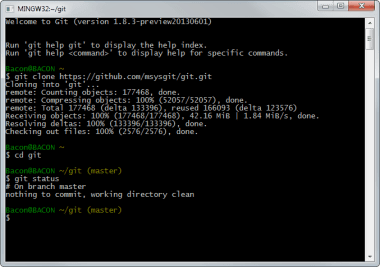

- #GITHUB MAC OS X HOW TO#
- #GITHUB MAC OS X INSTALL#
- #GITHUB MAC OS X CODE#
- #GITHUB MAC OS X PASSWORD#
run: mkdocs gh-deploy -force Step 4: Create a new branch in your GitHub project called gh-pages github/workflows/ci.yml and insert the GitHub CI configuration which is listed here name: ci Mkdir workflows Step 3: Create a file called. gitignore Step 2: Create two folders in your GitHub project folder mkdir. INFO - Start detecting changes Step 2: Build the pages in the folder “/site”, which will be added to your GitHub project python3 -m mkdocs build Integrate the documentation with GitHub CI Step 1: Add folder to. INFO - Documentation built in 0.57 seconds pymdownx.tilde Step 1: Preview your documentation locally python3 -m mkdocs serve Repo_url: /Įdit_uri: edit/master/Įmoji_index: !!python/name:Įmoji_generator: !!python/name:_svgįormat: !!python/name:_code_format Here is an example configuration for the mkdocs.yml file and here you find an example project, which is based on that configuration.
#GITHUB MAC OS X INSTALL#
MkDocs installation on Mac Step 1: Verify the brew installation brew -version Step 2: Change the folder permission to install python, if needed sudo chown -R $(whoami) /usr/local/lib/pkgconfigĬhmod u+w /usr/local/lib/pkgconfig Step 3: Install python3 brew install python3 Step 4: Upgrade pip pip3 install -upgrade pip Step 5: Install mkdocs pip3 install mkdocs Step 6: Install mkdocs-material pip3 install mkdocs-material Step 7: Install mkdocs-material-extensions pip3 install mkdocs-material-extensions Verify and build your documentation Step 1: Ensure you have the mkdocs.yml file in place The gif shows the example project documentation: Local setup on Mac OS Here an example GitHub project, which is based on the setup I documented in this blog post:

Steve Martinelli created an awesome blog post in that context called 5 Features I Like About Material for MkDoc. The blog post is for me a little cheat sheet and maybe it is also useful for you.

I won’t covering details about the background.
#GITHUB MAC OS X HOW TO#
$ git config -global blog post contains the simplified steps, how to setup MkDocs for a GitHub project to use it with GitHub Pages. Setting up Sublime Text as the Git Mergetool $ git config -global "subl -w \$MERGED" $ git config -global core.excludesfile ~/.gitignore DS_Store files in your Git repositories, you can configure your Git to globally exclude those files: # specify a global exclusion list DS_Store (a hidden OS X system file that's put in folders) to your. On a Mac, it is important to remember to add. Third, Add your keys to GitHub by going into account settings. Please use a strong passphrase for your keys. # Enter file in which to save the key (/Users/you/.ssh/id_rsa): # Generating public/private rsa key pair. $ ssh-keygen -t rsa -C Creates a new ssh key, using the provided email as a label The default settings are preferred, so when you're asked to "enter a file in which to save the key,"" just press enter to continue. Second, To generate a new SSH key, copy and paste the text below, making sure to substitute in your email. If you don't have either of those files go to step 2. Open up your Terminal and type: $ cd ~/.sshĬheck the directory listing to see if you have files named either id_rsa.pub or id_dsa.pub. Most of the instructions below are referenced from here.įirst, we need to check for existing SSH keys on your computer. This might be difficult to configure in case you have two factor authentication enabled.
#GITHUB MAC OS X PASSWORD#
So you don't have to type your username and password everytime, let's enable Git password caching as described here: $ git config -global credential.helper osxkeychain
#GITHUB MAC OS X CODE#
To push code to your GitHub repositories, we're going to use the recommended HTTPS method (versus SSH). $ git config -global user.email will get added to your. Next, we'll define your Git user (should be the same name and email you use for GitHub): $ git config -global user.name "Your Name Here" When done, to test that it installed fine you can run: $ git -versionĪnd $ which git should output /usr/local/bin/git. What's a developer without Git? To install, simply run: $ brew install git


 0 kommentar(er)
0 kommentar(er)
